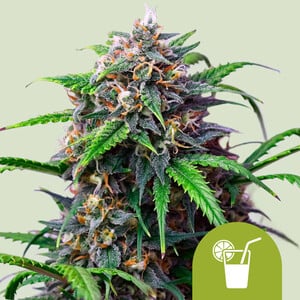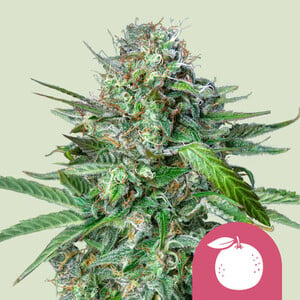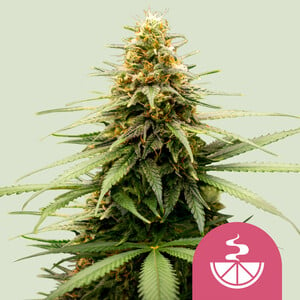.
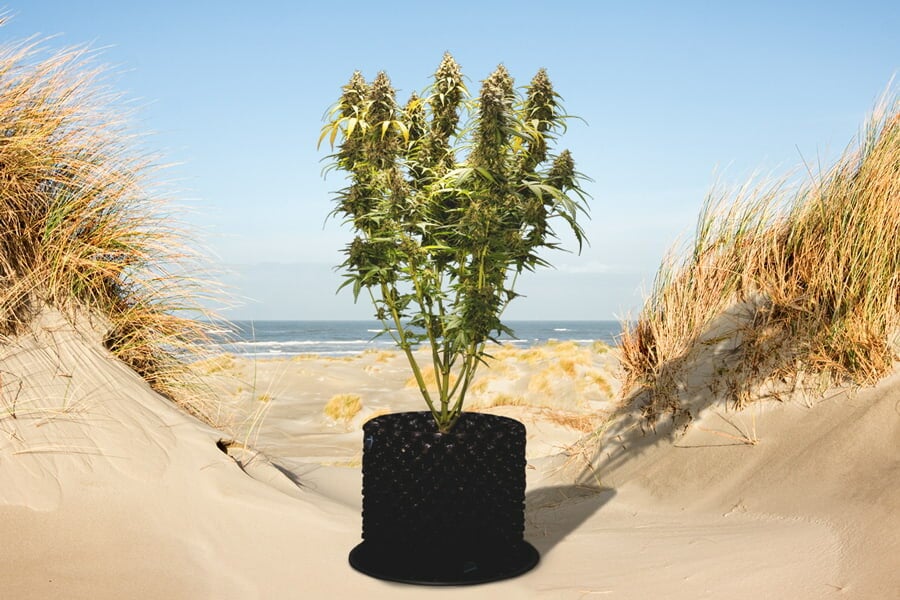
Growing Cannabis by the Sea: What You Need to Know
Cannabis is hardy and adaptable, but can it be grown by the seaside? In this article, we address the main considerations of growing weed by the beach, including salt content, wind, and tourists. Learn all you need to know to secure a bumper coastal crop!
Contents:
Rolling waves, the distant call of birds, and that salty air—living by the sea is something many of us dream about. But for those who make the dream a reality, is it possible to grow weed in such an environment? Whether you’re on the Atlantic, Pacific, or elsewhere, we’ll examine all you need to know about growing weed by the sea.
Can You Grow Cannabis on the Beach?
While there are some key factors beach-dwelling growers need to consider, it is possible to grow weed plants outdoors in these areas. Ultimately, it comes down to working with the local climate and conditions. Whether it’s strong, sandy gusts of wind or the high salt content of the water and air, growers need to anticipate the unique challenges of seaside growing if they want their operation to be a success.
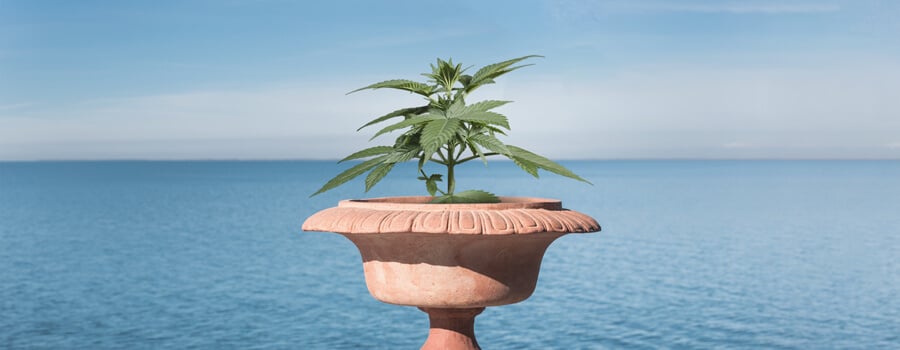
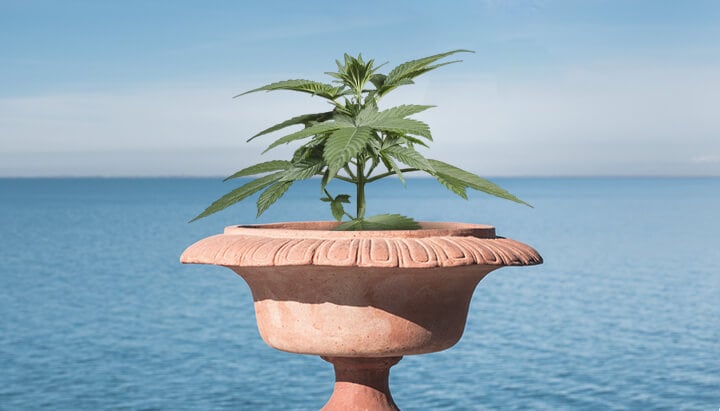
Is Cannabis Salt Tolerant?
You might not realise it, but cannabis needs salt! Whether you’re growing in soil or hydro, your cannabis plants should have access to sufficient levels of salt, either from the natural environment or administered by you. All water contains some degree of salt compounds that plants need to survive. However, concentration is key—too much or too little, and your plants will suffer.
For example, too much salt can result in nutrient lockout, preventing plants from absorbing nutrients from the substrate. It can also result in slowed, stunted plant growth, inhibited flowering, issues with photosynthesis, deficiencies, and more. Interestingly, research has shown that some cannabis strains are believed to handle higher salinity levels by maintaining high enough potassium levels to inhibit salt uptake[1].
Now, for weed plants grown on the coast, you’ll need to consider the salt content of both the air and the soil, as well as the water and nutrients you administer. For this reason, among others, it's best to plant in containers filled with cannabis-specific soil instead of directly in the ground—that way, you don’t have to worry about excessive salt from the environment making its way into the substrate. And when it comes time to administer water and nutrients, ensure you’re not adding too much salt. You can verify the total dissolved salts in the substrate by measuring the EC and PPM. Use an EC and PPM metre to dial in your substrate to optimal levels[2]—around 1.2–2.0 mS/cm EC and 700–1400 ppm.
How to Grow Cannabis Plants by the Sea
Without further ado, let’s break down the main considerations of growing weed plants by the ocean. All being well, you’ll be able to secure a high-quality crop of coastal cannabis!
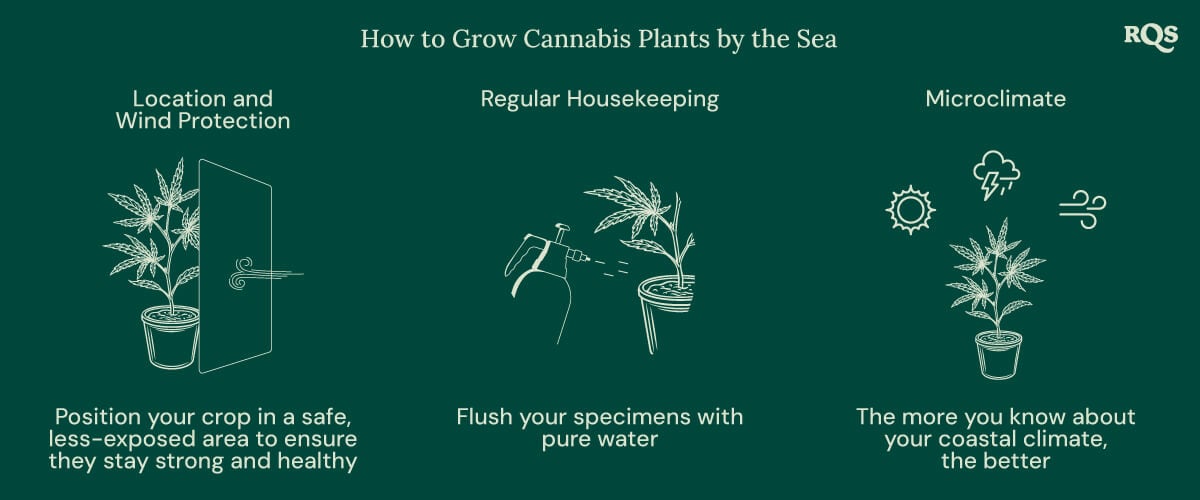
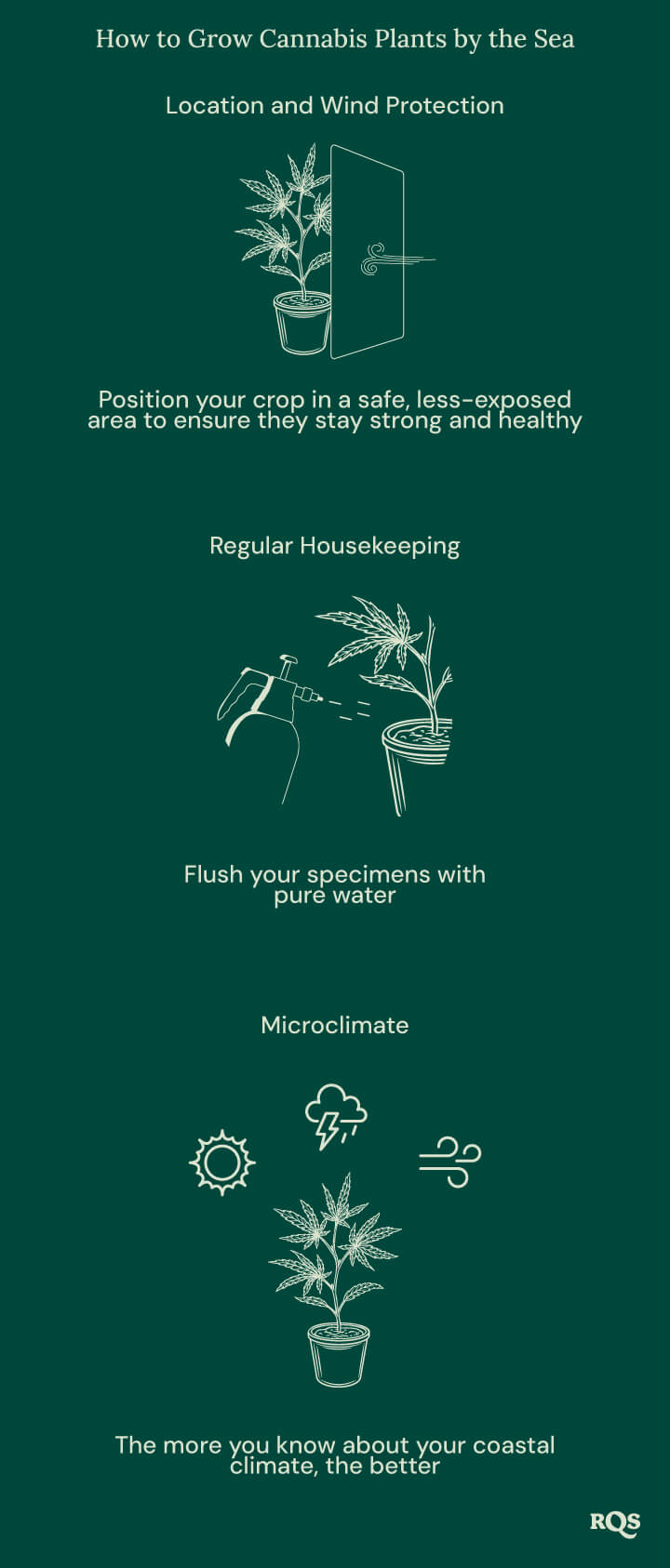
-
Location and Wind Protection Matter
Location, location, location—when growing by the ocean, where you position your plants is of the utmost importance. Of course, you don’t want to plant your crop right on the beach—for multiple reasons. To start, plants exposed to the harsh wind (and rain) associated with the coast are at a much greater risk of experiencing windburn and stem breakage. Moreover, blown sand can cause structural damage and other issues.
For this reason, creating adequate windbreaks or simply positioning your crop in a safer, less-exposed area can help to ensure they stay strong and healthy. In the event that you don’t have adequate wind protection, at least stake and tie your plants to keep them secure and upright. Again, it’s advised that you plant in pots, chiefly so you can control the content of the substrate but also so you can move your plants around during periods of harsh weather.
-
Regular Housekeeping Is a Must
Whether you’re growing directly on the beach or not, sand and debris carried by the wind can cause significant damage. Furthermore, these particles can make their way into your substrate and on the plants themselves. The same goes for the salt in the air, as salt deposited on the foliage dehydrates the plant over time. As such, keep a close eye on how your plants respond to their environment and perform regular housekeeping to keep your plants and their substrate in good condition. In the case of excessive salt deposits on the plants, consider gently rinsing your specimens with pure water.
-
Be Wary of Increased Footfall During the Summer Months
We’ve discussed the threats of wind and salt, but there’s another one to consider—prying eyes. During the summertime, coastal areas typically see a massive influx of tourists who might happen to wander upon your precious crop. Whether you’re worried about theft or alerting the authorities, there are actions you can take to keep your grow more clandestine. First of all, companion plants, especially those well-suited to coastal climates, can be a great asset to keep your weed plants out of sight while also providing all-important protection from wind and harsh weather.
Another consideration is that people love to fly their drones in these areas, so you’ll need to consider the visibility of your crop from above as well.
-
Understand Your Area's Microclimate
While it’s true for growers in any climate, those living in coastal areas really need to consider the unique microclimate in which they live. Different coastal regions vary dramatically in their conditions—some are hot and dry, while others are rainy and temperate. Therefore, if you plan to grow cannabis plants by the coast, there’s no one-size-fits-all approach; you'll need to do your due diligence and source recommendations from growers in similar areas. Whether it concerns the climate itself, timing and day length, or watering and feeding practices, the more you know about your coastal climate, the better.
Cannabis Strains to Grow by the Sea
Considering all the above, strain choice can play a vital role in the suitability of your crop for your coastal climate. While we can’t suggest strains for every coastal region, below, we’ll offer some examples to inspire your next seaside grow op.
Purple Lemonade Auto
Purple Lemonade Auto is a triple threat for coastal growers—it’s small and discreet, fast to reach harvest, and thrives in a wide range of environments. A fusion of Purple Haze, Lemon Skunk, and Sweet Skunk Auto, this strain is all about uplifting vibes and candy and citrus flavours. With a total grow cycle of 10–12 weeks, Purple Lemonade Auto will waste no time producing yields of up to 180g/plant outdoors. Meanwhile, it’ll reach no more than 1m in height, allowing growers to strategically position their plants for optimal growth and discretion. Given its autoflowering nature, Purple Lemonade Auto can be grown at essentially any time of year, giving coastal growers the opportunity to harvest this strain all year round!
Purple Lemonade Auto
|
|
Purple Haze x Lemon Skunk x Sweet Skunk Auto |
|
|
425 - 475 gr/m2 |
|
|
60 - 100 cm |
|
|
7 - 9 weeks |
|
|
THC: 22% |
|
|
Sativa 25% Indica 70% Ruderalis 5% |
|
|
130 - 180 gr/plant |
|
|
70 - 120 cm |
|
|
10 - 12 weeks after sprouting |
|
|
Euphoric, Physically Relaxing, Uplifting |
Tangie
Tangie offers a bit of a different approach. This sativa-dominant descendant of California Orange and Skunk takes a bit longer to flower, but in doing so, it maximises the quality and quantity of your harvest. For seaside growers in regions with long, hot summers, this specimen is just perfect. However, note that plants may need some training to keep height under control unless you’re okay with letting them max out at almost 2m. In optimal conditions, Tangie can churn out up to 700g/plant when harvest time comes around in October. Plus, with its euphoric high and citrus and pineapple flavours, Tangie screams tropical bliss!
Tangie
|
|
California Orange x Skunk |
|
|
450 - 550 gr/m2 |
|
|
80 - 120 cm |
|
|
9 - 10 weeks |
|
|
THC: 20% |
|
|
Sativa 70% Indica 30% |
|
|
650 - 700 gr/plant |
|
|
150 - 190 cm |
|
|
October |
|
|
Focus , Uplifting |
Lemon Skunk
Finally, we have Lemon Skunk, a balanced indica/sativa hybrid derived from Skunk #1 x Citral. With a fast flowering time of just 8–9 weeks, Lemon Skunk is suitable for coastal growers who may be subject to rain and cooler conditions early on in autumn—generally, this strain is ready to harvest in late September. Reaching heights of 120–150 cm outdoors, Lemon Skunk is reasonably compact and can be kept even more so through topping and LST. As with any good Skunk, Lemon Skunk can deliver significant yields of up to 675g/plant outdoors. Once they're ready to go, enjoy a joint on the beach, and bask in the skunky citrus flavour before enjoying a long-lasting, relaxing high.
Lemon Skunk
|
|
Skunk 1 x Citral |
|
|
600 - 650 gr/m2 |
|
|
80 - 120 cm |
|
|
8 - 9 weeks |
|
|
THC: 19% |
|
|
Sativa 50% Indica 50% |
|
|
625 - 675 gr/plant |
|
|
120 - 150 cm |
|
|
Late September |
|
|
Calming, Creative, Long Lasting , Physically Relaxing |
Oh, I Do Like to Grow Beside the Seaside
Ready to grow your own weed plants at the beach? With a bit of care and planning, you can harvest a crop of coastal cannabis that will give “ocean grown” an extra-special meaning. By embracing the environment, you can maximise cannabis’ natural versatility and adaptability.
- Agronomy | Free Full-Text | Key Cannabis Salt-Responsive Genes and Pathways Revealed by Comparative Transcriptome and Physiological Analyses of Contrasting Varieties https://www.mdpi.com
- Understanding EC and PPM in Cannabis Growing: A Comprehensive Guide - Blog https://floraflex.com


























